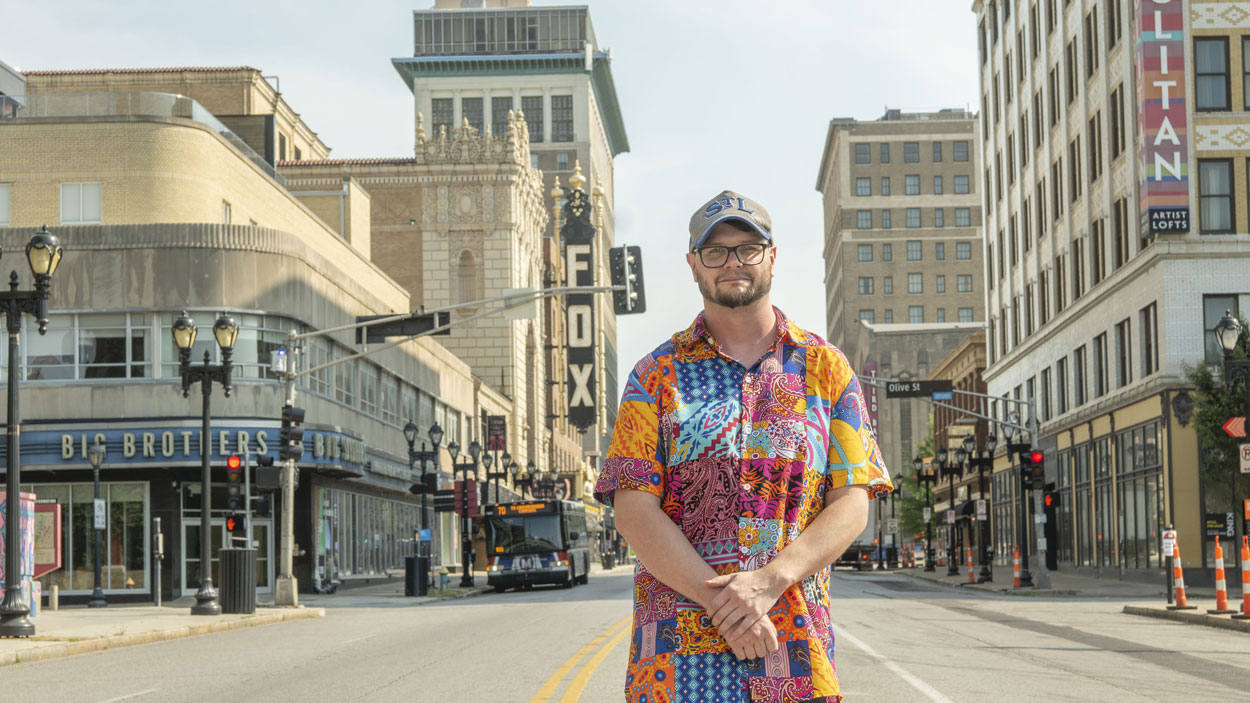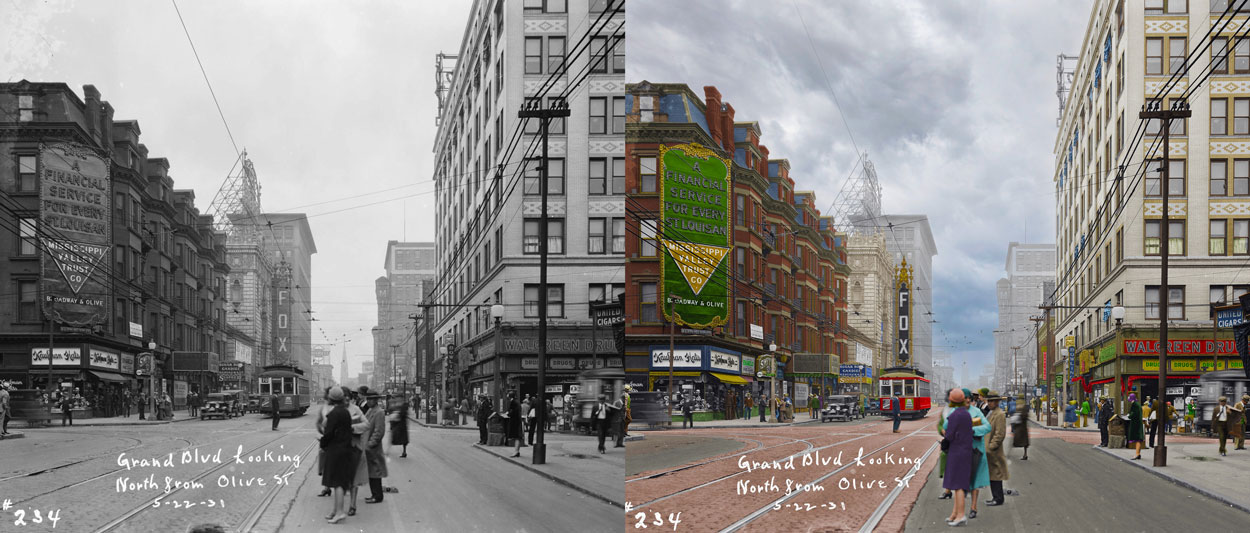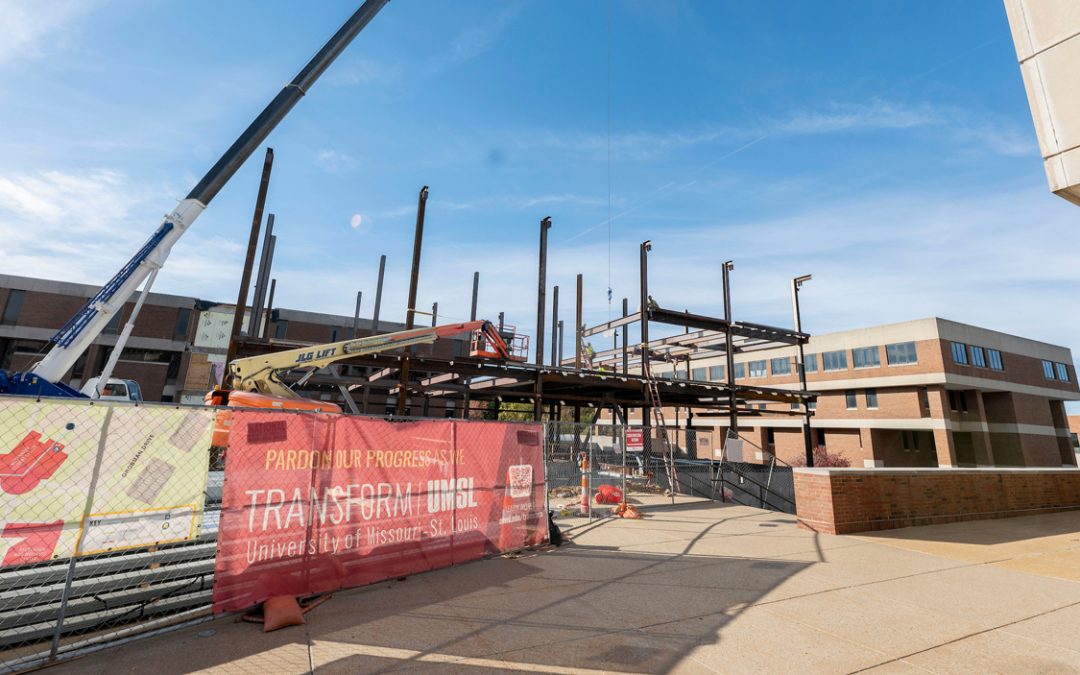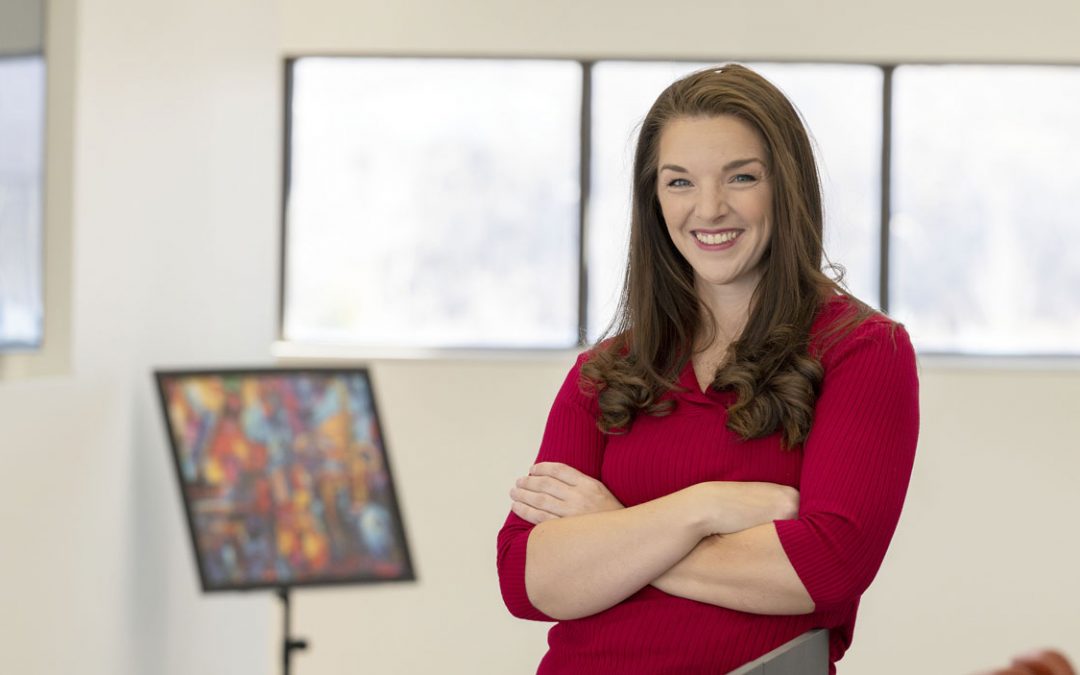
History alum Mark Loehrer stands in the middle of Grand Boulevard with The Fabulous Fox Theatre behind him. That stretch of road through Midtown is also featured in one of the many historic photos that Loehrer has brought back to life by colorizing it and posting it to his Instagram account, archcityhistory. (Photo by Derik Holtmann)
Collections of old photographs remain the closest thing this society has to time travel.
University of Missouri–St. Louis alum Mark Loehrer has found a way to bring them to life even more by colorizing them, and for the past seven years he has been offering a glimpse into early 20th century life around St. Louis through the work he creates and posts to his Instagram account, archcityhistory.

Mark Loehrer colorized this 1948 photo of the St. Louis Arena. The original black and white image is part of the collection at the Missouri History Museum. (Screenshot from archcityhistory on Instagram)
Loehrer, who earned both his bachelor’s and master’s degrees from UMSL, the latter completed in 2021, has built an audience of more than 15,000 followers on the platform. They’re drawn to images of landmarks they might recognize or remember, such as the old St. Louis Arena or Bevo Mill, but also slices of everyday life, including a photo of young Black men celebrating after heavyweight Joe Louis knocked out German boxer Max Schmeling in the first round of their rematch in 1938.
He has also posted images of street scenes from around the city that help people connect the past to the modern day.
“I have a whole series along Gravois,” Loehrer said. “Comparing Gravois then and now, people really got kind of amazed because they see some things that they recognize – like the little material yard at Cherokee and Gravois that is still there to this day – and then there’s buildings that don’t look the same. Sure enough, they were taken away from street widening.
“For me, it’s a really cool blending of urban history, which I’m interested in, with the transformation of the landscape through city planning – widening of roads because of growth of the city – and sort of a glimpse of yesteryear. But it’s close enough to the present that we can still recognize it.”
Loehrer first got inspired to try colorizing old photos while watching Peter Jackson’s groundbreaking 2018 World War I documentary, “They Shall Not Grow Old,” which helped viewers experience events filmed a century earlier with restored footage using color and modern film techniques. At first it seemed a bit daunting.
“If you look at that movie, they were coloring the actual film strips by hand,” he said. “I thought, ‘I can never do that, but let’s see if we can find a shortcut.”

Mark Loehrer created this colorization of fans in St. Louis celebrating Joe Louis’ historic first round knockout of German champ Max Schmeling at Yankee Stadium on June 22, 1938. The original black and white photograph is was by longtime St. Louis Post-Dispatch photographer Art Witman and is part of the collection at the State Historical Society of Missouri. (Screenshot from archcityhistory on Instagram)
He quickly discovered software tools that would aid in his efforts. He began by using a free program, GIMP – which stands for GNU Image Manipulation Program – but has since upgraded to Adobe Photoshop.
“It’s really just a matter of making selections and then increasing the hue and saturation and changing the color, and miraculously, that does it,” he said. “It’s really just trial and error.”
It’s still a meticulous process, and Loehrer estimates he can spend up to 10 hours colorizing one image.
There’s sometimes just as much work involved in the research. When he first got started, he used to make visits to the sites contained in the photographs, hoping to ensure the color of the brick he used matched the modern-day building, or he’d dig through old newspapers and other archives to see what colors were used in signs for Coca-Cola or beer.
He still wants his work to accurately reflect the past but isn’t as dedicated to hyperrealism.
“What I want to do is turn the picture into a painting,” said Loehrer, who has also done commissioned work, including for the Jersey County Historical Society in partnership with Carrollton Bank in Jerseyville, Illinois.
He’s found no shortage of captivating images in libraries and archives around the region. The Lemen Streets and Sewers Collection at the St. Louis Public Library and the collection of work from longtime St. Louis Post-Dispatch photographer Arthur Whitman at the State Historical Society of Missouri are two of the richest troves from which he’s worked.
He has been grateful to discover a way he can make history more accessible and engaging.

Mark Loehrer took the black and white 1931 photograph of Grand Boulevard from The Lemen Streets and Sewers Collection on the left and brought it to life by colorizing it. (Original photograph from The Lemen Streets and Sewers Collection at the St. Louis Public Library; Colorized image from Mark Loehrer)
Loehrer credits his time at UMSL for showing him how enchanting history can be, especially when one experiences it outside of a textbook. He was particularly impacted by his exposure to The Virtual City Project, led by Professor Andrew Hurley, which employed three-dimensional imaging technologies to create electronic representations of lost historic landscapes.
“Just realizing that history doesn’t have to be just reading and writing,” Loehrer said. “It could be putting things online. It could be looking in the archives.”
Loehrer wound up working as a graduate assistant under Hurley while pursuing his master’s degree.
He also had graduate internships at the State Historical Society of Missouri and The Griot Museum of Black History, founded in 1997, which showcases life-size wax figures, historical artifacts and other immersive exhibits highlighting the contributions of African Americans in St. Louis.
In 2018, he was hired as a graduate research assistant to Harvard University Professor Walter Johnson and spent a year helping him gather historical information – including archival resources and data related to civil rights, community organizing, labor history and St. Louis politics – for his acclaimed book “The Broken Heart of America: St. Louis and the Violent History of the United States,” published in 2020.
Since 2019, Loehrer has served as a curatorial assistant at the Missouri Historical Society. For the past two years, he has been part of the content development team, contributing research and copywriting, for an exhibit on Mill Creek Valley, a historic neighborhood in St. Louis’ central corridor that was razed in the 1950s as part of an urban renewal project. His main contributions have centered on entertainment, highlighting everything from baseball and boxing to jazz clubs, musicians and movie theaters in the neighborhood. The exhibit is scheduled to open in November at the Missouri History Museum.














